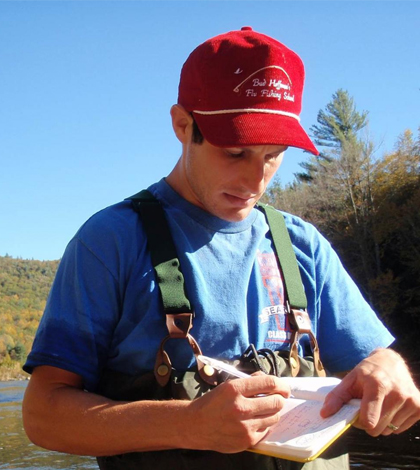Researchers conduct first-ever analysis of water loss during hydropeaking

Brian Yellen records measurements during a hydropeaking event in the Deerfield River. (Credit: University of Massachusetts Amherst)
Hydroelectric dams are often touted as a fairly clean, versatile source of power. While coal-fired power plants must maintain a constant output rate, hydroelectric dams can provide power as it’s needed through a process known as hydropeaking, in which water is released during periods of peak power draw to meet demand.
Despite the practice’s widespread application, the effects of hydropeaking on local environments hadn’t been thoroughly examined — that is, until two University of Massachusetts Amherst researchers conducted a study revealing some unforeseen tradeoffs. Published in the journal Hydrological Processes, the paper detailing the study’s findings says that 10 percent of water released during hydropeaking is permanently lost.
Brian Yellen, a UMass doctoral candidate who earned his master’s through the study, has observed hydropeaking in action from a young age.
“I grew up fishing,” Yellen said. “My dad would always warn me: When you’re fishing in the river, make sure you watch a rock or something that’s only three or four inches above the surface. If you notice that it’s all of a sudden below the surface, get out of the river.”
Downstream of a dam, hydropeaking essentially creates conditions similar to natural flooding, during which water levels can fluctuate by several feet. While this can create a temporary hazard to unwary waders and anglers, the influx is soon absorbed into the groundwater system through a process called bank storage.
“It happens during normal floods, and it allows water levels to attenuate somewhat,” Yellen said. “On hydropeaking rivers, instead of happening every now and then during natural floods, it happens every day during dam releases.”
The study, which Yellen conducted alongside his advisor and UMass assistant professor David Boutt, aimed to quantify the inputs and outputs of water at different points in the Deerfield River following hydropeaking release. Previous studies had only examined singular points in a river; Yellen and Boutt tackled a 13-mile stretch of theirs.

Yellen called the study a work of “accounting,” as each day was spent making fine-scale measurements of water entering the river from its tributaries and exiting through the sediment. The duo spent plenty of time inserting probes a few feet below the riverbed to see how sediment permeability affected the rate of bank storage. Quantifying size, duration and water lost for every dam release — each of which lasted between seven and 10 hours — the researchers quickly accrued a large data set.
Although all that careful bookkeeping offered answers to some of the researchers’ questions, it also revealed something totally unexpected, Yellen said: Up to 10 percent of water released during hydropeaking seemed to vanish. Unable to find the missing water in the river or groundwater, the researchers developed a hypothesis that they feel explains the strange phenomenon.
“On days with warmer weather, the trees are actually sucking water out of the banks,” Yellen said. The steady pattern of dam releases raises the water table enough that the roots of nearby trees gain access to it. While the trees eagerly sip from the excess reserves, downstream municipal infrastructure, agricultural operations and riverine biota are denied a significant portion of their daily water.
The limited scope of the study prevented the researchers from exploring the direct effects of hydropeaking on these users, but Yellen says “there’s no doubt that there’s going to be impacts.” Furthermore, Yellen noted that the study should be understood as an examination of hydropeaking in a particular region.
“We only studied this on a 13-mile stretch of river,” Yellen said. “The bottom line is that the losses could be even greater than what we document.”
Yellen isn’t suggesting that hydroelectric dams cease hydropeaking — the practice is partly what makes hydropower so efficient. But the study does indicate that there are additional tradeoffs to consider when employing hydropower, and more research should be conducted to determine the extent of those tradeoffs.
“The question remains,” Yellen said. “Does this process operate across all environments across the United States, or does it only occur in the Northeast?”
Top image: Brian Yellen records measurements during a hydropeaking event in the Deerfield River. (Credit: University of Massachusetts Amherst)




0 comments